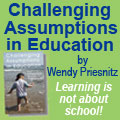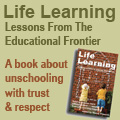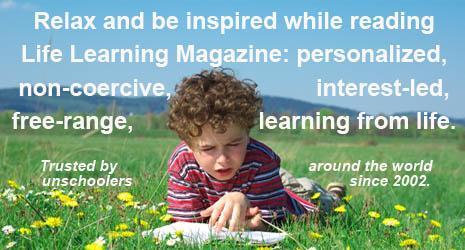|

Unschooling is Education Inspired by Nature
by Wendy Priesnitz
“Look deep into Nature, and then you will understand everything better.” ~ Albert Einstein
A few months ago, I began research for an article about biomimicry for Life Learning Magazine’s mother magazine Natural Life. As serendipity would have it, around the same time, a Twitter contact suggested that I write an article for Life Learning about how biomimicry relates to life learning (unschooling). Oh, yes, I thought: Learning is one of Nature’s most elegant devices! However, we humans are the only species that sends our offspring to school in order to learn and to socialize. (We may also be the only species that stubbornly refuses to learn from our mistakes – even the famous lemmings who are supposed to blindly follow each other jumping off cliffs are reportedly a Disney fabrication.)
The term “biomimicry” comes from the Greek words bios, meaning life, and mimesis, meaning to imitate. It is the examination of Nature, its models, systems, processes, and elements in order to find solutions to human problems. By emulating Nature’s patterns, its goal is to create new ways of living and of designing policies and products that are well-adapted to life on earth.
An early example of biomimicry (although it wasn’t called that at the time) is the study of birds to enable human flight. Although never successful in creating a “flying machine,” Leonardo da Vinci was a keen observer of the anatomy and flight of birds, and made numerous notes and sketches on his observations as well as sketches of various “flying machines.” Likewise, the Wright Brothers, who finally did succeed in creating the first airplane in 1903, apparently gained inspiration for their airplane from observations of pigeons in flight.
Modern biomimicry research has inspired adhesive glue from mussels, solar cells made like leaves, fabric that emulates shark skin, harvesting water from fog like a beetle, and more. The fastening marvel called Velcro® inspired by the tiny hooks found on the surface of burs, carbon-sequestering cement inspired by corals, and energy efficient wind turbines inspired by schooling fish are other examples of biomimicry being used to create better products in the modern world. In fact, the green building sector has enthusiastically embraced biomimicry as an interdisciplinary way to investigate the design of buildings that move beyond current definitions of sustainability towards regenerative and restorative.
How would Nature solve our so-called educational crisis? Biomimicry would suggest that education should be decentralized, self-regulating, co-operative, resourceful, always adapting and shifting in response to new information and changing conditions, active and always in motion, with built-in feedback mechanisms.
Biomimicry can also be used to create new organizational structures and systems. In an article in Fast Company magazine, Alissa Walker describes how, as part of the magazine’s What Would You Ask Nature? biomimicry challenge, the US Green Building Council (USGBC) reinvented its operating structure using biological principles and with the help of design and innovation consulting firm IDEO. They needed to replace their hierarchical, top-down approach with a more flexible one that created a stronger sense of community and connectedness among members. They found their inspiration in mycorrhiza fungi, which grow in a symbiotic relationship with trees, sharing and circulating nutrients among them. Walker writes that, “the designers instantly realized it was a perfect model: What if, instead of a hierarchical relationship, the national body (like the fungi) was in a supportive relationship with chapters (the trees), moving information and resources around as necessary?“
This USGBC organizational redesign wasn’t just an improvement of an existing structure; it was a complete stripping down and rebuilding from the basics. In their book Cradle to Cradle: Remaking the Way We Make Things, authors William McDonough and Michael Braungart suggest that this is the most sustainable path, rather than merely adapting and trying to improve harmful ways of doing things. “Being less bad is not the same as being good," they write.
And that brings us back to our education system. Why settle for the least harmful alternative when we could have something that is better – something that mimics Nature’s ever-adapting and evolving attempts to remediate damage and create optimum conditions for growth?
Our warehouse/prison style of schooling processes students in preparation for the past rather than the future, and largely ignores the potential of new technologies and emerging worldviews. So educational reformers should be building entirely new paradigms, rather than merely tinkering and ending up with something that’s arguably “less bad,” like they’ve been doing for decades.
So how would Nature solve our so-called educational crisis? Biomimicry would suggest that education should be decentralized, self-regulating, co-operative, resourceful, always adapting and shifting in response to new information and changing conditions, active and always in motion, with built-in feedback mechanisms. Doesn’t that look a lot like life learning?!
Clearly, Nature wouldn’t create dedicated school buildings full of desks. It wouldn’t coop kids up indoors all day and even get rid of outdoor play time in favor of sitting at those desks. It wouldn’t create a top-down hierarchy where there is a high ratio of young students to adult “experts,” standardized curriculum, tests, or grades. There wouldn’t be passing and failing or report cards.
A biomimicry-inspired education system might borrow from the way the fringe-lipped bat learns to use frog calls from different species as acoustic cues to assess the palatability of its prey. In a study published in 2006, researchers Rachel Page and Michael Ryan at the University of Texas at Austin investigated the role of social learning and cultural transmission in bat foraging. Comparing three different learning groups, they measured the rate at which bats learned new foraging information: in this case, the experimental association of the calls of a poisonous toad species with the presence of edible prey. The researchers tested the effectiveness of learning this experimental association and concluded that the best results came from a social learning group, in which a bat inexperienced with the new call-food association was allowed to observe an experienced bat.
Or a new education paradigm might resemble the way honey bees collaborate as they make decisions about selecting a new hive. They choose the best site through a democratic learning process that humans would do well to emulate, according to Cornell University biologist Thomas Seeley. In his new book Honeybee Democracy, Seeley describes the elaborate decision-making that bees use. It is similar to how neurons work to make decisions in primate brains, he says. In both swarms and brains, no individual bee or neuron has an overview but, with many independent individuals providing different pieces of information, the group achieves optimal decision-making.
“Consistencies like these suggest that there are general principles of organization for building groups far smarter than the smartest individuals in them,” Seeley writes. The bees’ collaboration process is being used as a biomimicry model by researchers at the University of Illinois at Urbana-Champaign who are looking at ways to improve disaster relief efforts.
Collaboration is, indeed, an important part of the new kind of networked learning environment that is developing to replace the factory model we’ve been using for the past while. The Fast Company article that I referenced earlier quotes a USGBC staffer who said that the organization would be successful when the national body was learning as much from the chapters as the other way round. With the help of the biomimicry designers, Nature’s fungi/tree symbiosis model was taking the organization in that direction.
School systems, however, have not awakened to the possibilities of collaboration. In fact, their centralized, top-down organization means they aren’t even focused on the needs of children, let alone including them as collaborators in their own lives and those of their school communities. Instead, schools serve the educational industry of text book manufacturers, test creators, and teacher training; their mandate includes feeding the economy with workers and consumers; and children are expected to swallow the medicine the experts prescribe. And that medicine is the same for all and fundamentally not much different than it was decades ago.
Nature, as we have seen, operates more sensitively. It creates habitats where each organism is adapted to its place and its conditions. As habitat conditions change, organisms are continuously developing and changing in synch in order to survive. The maverick American ecological economist Herman Daly has pointed out that as a species, our habitat conditions have changed as our population has grown, but our strategies have not. So, too, with education.
Nature’s design for education would look a lot like the life learning community – participatory and self-managing, rather than being run by a hierarchy of outsiders. As in Nature, individuals of all ages would manage their own behaviors by setting personal standards and evaluating their performance in relation to these standards. That is, of course, how children develop until school teaches away that power and turns active learners into passive receivers of information.
Life learning is one of the forces – along with technology, which is allowing learners to connect directly with the global knowledge commons and to bypass schools altogether – behind the paradigm shift that is underway in education. Schools and their related industry may or may not reconfigure themselves around this change, or we may see an entirely new type of system emerge to organize and ensure equitable opportunity. (Even that seems like it could be redundant and unnecessary…and, in any case, it’s irrelevant to whether or not learning happens. But then again, Nature does like to build in redundancy!)
A few educational reformers understand how profoundly the life learning philosophy differs from the current norm. However, most will merely co-opt those aspects and language that fit their minor rejigging of schools. But that’s okay, because life learners are on solid ground, having followed our instincts and designed a new way of living based on billions of years of natural development. Our lifestyle is an elegant amalgam of the natural and high-tech worlds, a combination of art and cutting-edge science.
And if the biomimicry model is good enough for designing efficient high-speed trains, replacements for buttons and laces, and passive air conditioning, then it’s a great model for reinventing and revitalizing how our families live and learn. After all, learning how to live and adapt within our habitat is just, well, natural.
* * *
About Biomimicry
In 1960, the term “bionics” was coined by psychiatrist and engineer Jack Steele to mean “the science of systems which have some function copied from Nature.” However, the word’s later misuse in connection with electronically-operated artificial body parts and the 1974 television series The Six Million Dollar Man led to it being dropped by the scientific community. Otto Schmitt, an American academic and inventor, coined the term “biomimetics” to describe the transfer of ideas from biology to technology and it first appeared in the Websters Dictionary in 1974. The term “biomimicry” appeared as early as 1982 but was popularized by scientist and author Janine Benyus in her 1997 book Biomimicry: Innovation Inspired by Nature. Benyus suggests looking to Nature as a “Model, Measure, and Mentor” and emphasizes sustainability as an objective of biomimicry.
The principles of biomimicry were developed by Janine Benyus. They include:
- building from the bottom up
- self-assembling
- optimizing rather than maximizing
- using free energy
- cross-pollinating
- embracing diversity
- adapting and evolving
- using life-friendly materials and processes
- engaging in symbiotic relationships
- enhancing the bio-sphere
The characteristics of biomimicry-inspired optimum systems design include:
- form fits function
- resilience
- decentralization
- effectiveness and good performance
- abundance (using what’s at hand)
- bottom-up design
- cooperation and collaboration
- the whole is greater than the sum of its parts
“The more our world functions like the natural world, the more likely we are to endure on this home that is ours, but not ours alone.” ~ biologist and biomimicry popularizer Janine Benyus
Learn More
Ask Nature
Biomimicry: Innovation Inspired by Nature by Janine Benyus (William Morrow, 1997)
Cradle to Cradle: Remaking the Way We Make Things by William McDonough and Michael Braungart (North Point Press, 2002)
Biomimicry Institute
Honeybee Democracy by Thomas D. Seeley (Princeton University Press, 2010)
Wendy Priesnitz is the founder and editor of Life Learning and Natural Life Magazines, the author of thirteen books, and the mother of two adult daughters who learned without school in the 1970s and '80s.
Copyright © Life Media
Privacy Policy
  
  

|

